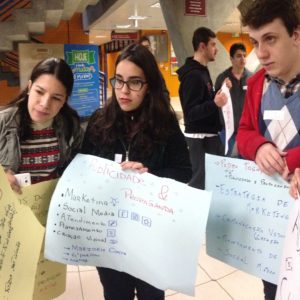I presented a drafty paper at INSCOPE, a conference about Social Innovation. My goal was to get some feedback about the theoretical framework I’m working on to link creativity to organizational change. Instead of taking creativity as an eureka moment or as talent of an individual, I take it as a social process.
According to Activity Theory, social process are shaped by contradictions. Suppose that one subject participating into an activity realizes something that could be changed, but because of current division of labor (or any other limit), he can do nothing about it. This contradiction between subject and the division of labor will get more tense, but hidden, until a conflict arise.

During explicit conflicts, subjects have the opportunity to externalize their opinions about how the activity is going. This is a normal tendency in subject participation: first he internalize activity features, then gradually tries to improve it by giving his own perspective.

Conflicts are often expressed in ritualized setups, like meetings. Contradictions that have been accumulating tension comes up and subjects must deal with stuff that they didn’t want to. What one thinks it’s a problem, it’s a not even an issue for others. And what one thinks it’s a solution, it’s in fact a problem for another. The garbage can model states that problems and solutions are developed separately by different streams in an organization and, at some point, they are thrown out during ritualized setups.

Two years ago, a student of mine at Faber-Ludens developed a game for this kind of meetings. The game stimulate groups to generate a lot of problems and solutions at the same time, organizing them into threads. I have done an experiment with Engineering students last month, but I didn’t have time to look at the data and bring some relevant data.

The main output of the game, in my opinion, is that it helps the team to be aware of contradictions that cannot be easily solved and better to learn how to live with them.
ABSTRACT
There are many studies on how individuals solve problems in a creative way but few on how the collective that the individual make part turn solutions into changes. We propose that creativity starts from the individual but is not fully realized until it gets into the collective. The collective must be conscious about the contradictions in order to embrace change. The lack of studies on collective creativity makes researchers and practitioners underequipped to deal with complex design process where multiple actors interacts. This paper presents and discusses a design game that takes problems and solutions as placements to find activity contradictions and raise consciousness about the possibilities for change.
van Amstel, F.M.C; Silveira, G.S; Hartmann, T. (2011) A Problem-Solving Game for Collective Creativity. Annual INSCOPE-Conference, Enschede – Netherlands.

